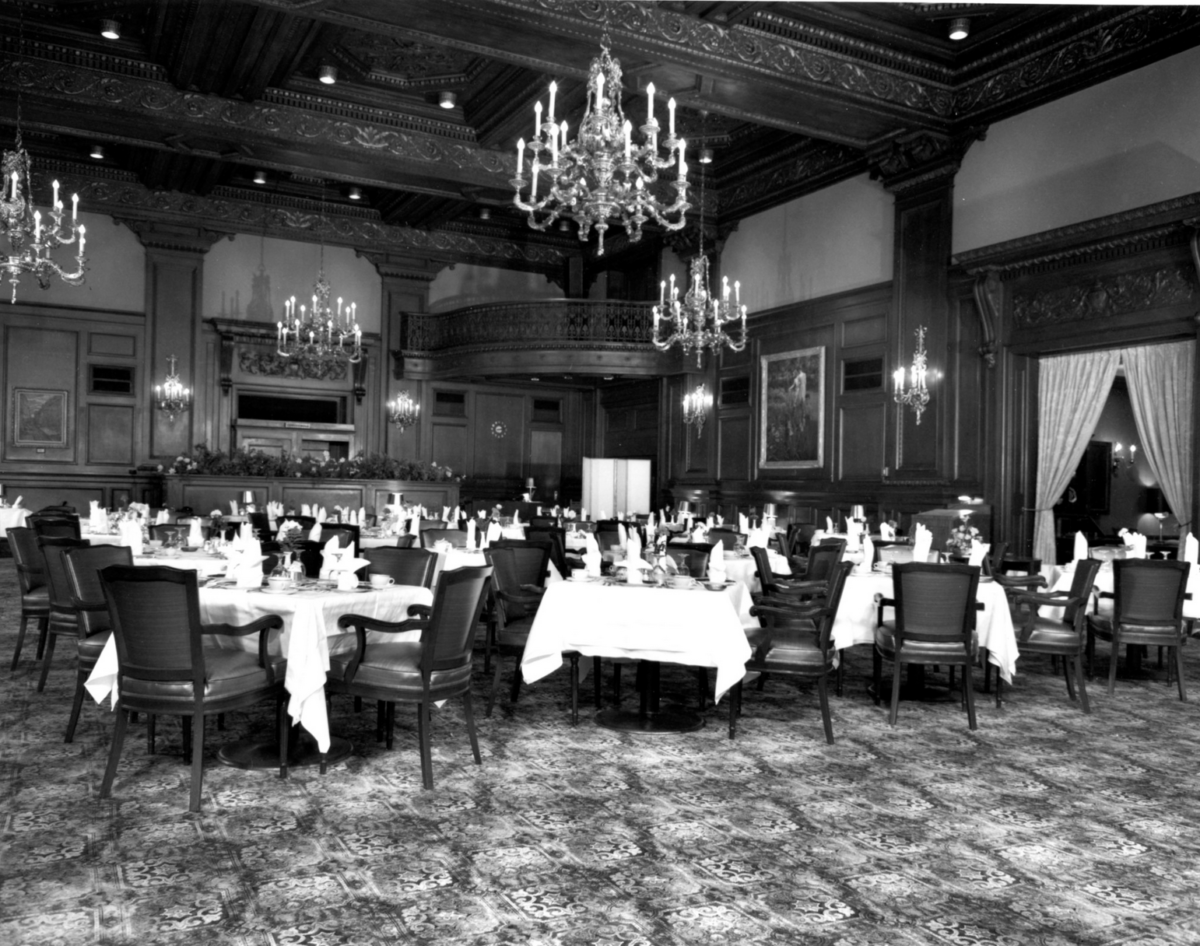The Green Room begat a bevy of celebrated Delaware chefs
Not so long ago, no holiday season was complete without brunch in the Green Room—the epitome of fine dining—in the Hotel du Pont. Sharing a seasonal meal under the 2,500-pound chandeliers was a tradition for generations of Delawareans.
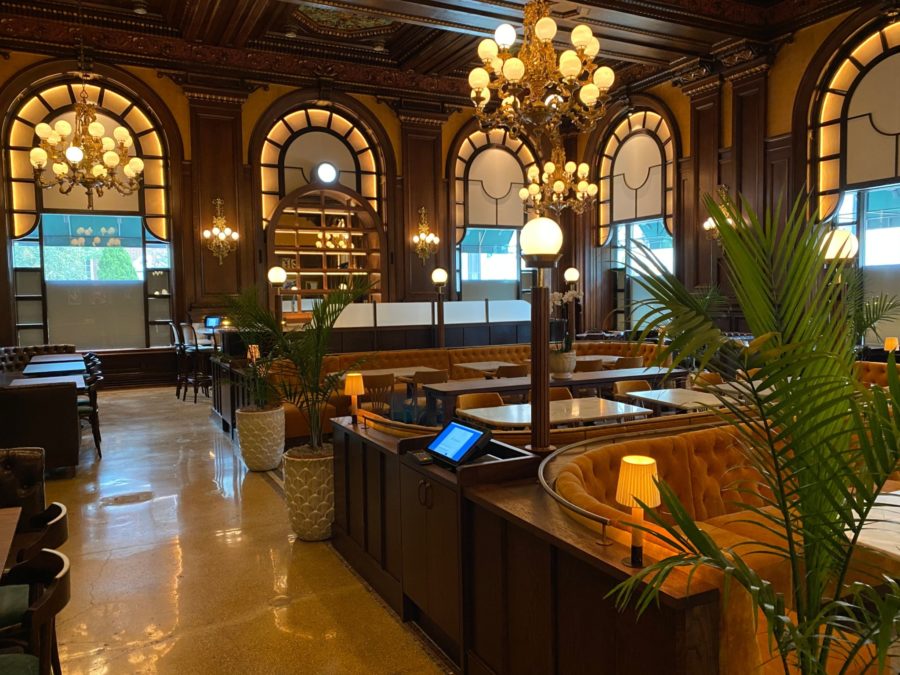
Today, The Buccini/Pollin Group owns the landmark hotel, and Le Cavalier at the Green Room, a modern brasserie, opened in September in the Green Room’s space. Brunch is available on weekends.
But the whisper of The Green remains. There are traces of the cuisine and the impeccable service in restaurants throughout the Brandywine Valley. And for a very good reason: Many of the hotel’s former chefs are now restaurant owners.
Consider Tom Hannum, the executive chef and an owner of Buckley’s Tavern; Dan Butler, owner of Piccolina Toscana; David Leo Banks of Banks’ Seafood Kitchen & Raw Bar; Bill Hoffman of The House of William & Merry; and Dan Sheridan, who owns Stitch House Brewery and Locale BBQ Post.
“That kitchen has turned out many of the greats in our state,” says alum Robbie Jester, who’s appeared on the TV shows Guy’s Grocery Games and Beat Bobby Flay.
Built to Endure
A 12-story tribute to Italian Renaissance architecture, the Hotel du Pont was built by the DuPont Co. to provide clients and visiting executives with upscale accommodations akin to those in Europe. It opened to great fanfare in 1913.
Rumor has it that Helena Springer Green—wife of John Raskob, the DuPont Co.’s secretary-treasurer—inspired the main dining room’s name. In the press, it is referred to as “the green room” as early as 1914. Others say that title was coined in the 1940s when the ceiling and rug were green.
From the start, diners admired the colossal chandeliers, fumed oak paneling and coffered ceiling. In 1965, the dining room received an overhaul that included the addition of 18th-century antiques and reproductions.
In 1975, the Philadelphia Inquirer reported that The Green Room had one of the “largest and best kitchens around.” It was “the culinary center of the universe in Delaware,” maintains Tom Hannum, who started working at the hotel after graduating from the Culinary Institute of America in 1978. “It was the only place in Delaware for fine dining and for serving French cuisine.”
The Old Guard
The European sensibility extended to the kitchen, which had a clear hierarchy and layers of job titles. Many managers were from Europe.
When Hannum joined the hotel as a line cook, Hubert Winkler was the executive chef. “He was a typical Type A Austrian chef,” Hannum recalls. “If you didn’t do it right, you heard about it. ‘Do what you were shown, exactly how you were shown and reproduce it that way every time.’ The expectation was to be the best.”
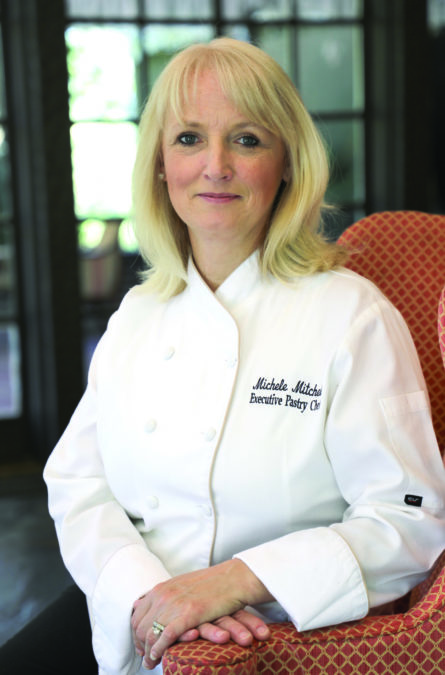
Dan Butler, who started his culinary career in the dish room, agrees. Winkler, who had worked in Switzerland before coming to Wilmington in 1973, had a practiced “side-eye.” When he saw something he didn’t like, it was as though an invisible hook came out of his eye to prod you back in line, Butler recalls.
Winkler wowed a young Patrick D’Amico with his expensive food orders. Foie gras and unique cuts of meat were “mind-blowing at the time,” says D’Amico, who came on board in 1986. Thirty years later, Bill Hoffman would gaze open-mouthed at mounds of truffles and $25,000 worth of caviar flown in for a wedding.
Not all the mentors were male. Maria “Mania” Rusak struck terror into the hearts of young cooks like David Leo Banks, who joined the hotel pantry in 1978. Nicknamed “Sparky” by Chef Hayden Byrd, the energetic Banks initially ran between the production areas: central prep, bakeshop, butcher shop, commissary and storeroom.
When Banks moved to the breakfast line, he worked under the East German, who was “super competent and ‘strong-like-bull,’” Butler says. Both Winkler and Rusak were demanding. “They instilled in me the strict discipline of the craft and the speed required to do it fast and, most of all, correct,” Banks says.
To be sure, if you were a “good cook” at the hotel, you were fast, Butler notes. “If you were a bad cook, you were slow. It was all about speed.”
Riding the Wave
Working your way up the ladder had special meaning for Butler, who began his career on the hot end of a dishwasher conveyor belt. Workers there got a face full of steam and a handful of blistering plates. “If you’re good, you get to be the guy loading the dishwasher,” he says. “If you’re really good, you get to do silverware.” It was a banner day when he started working in the pantry.
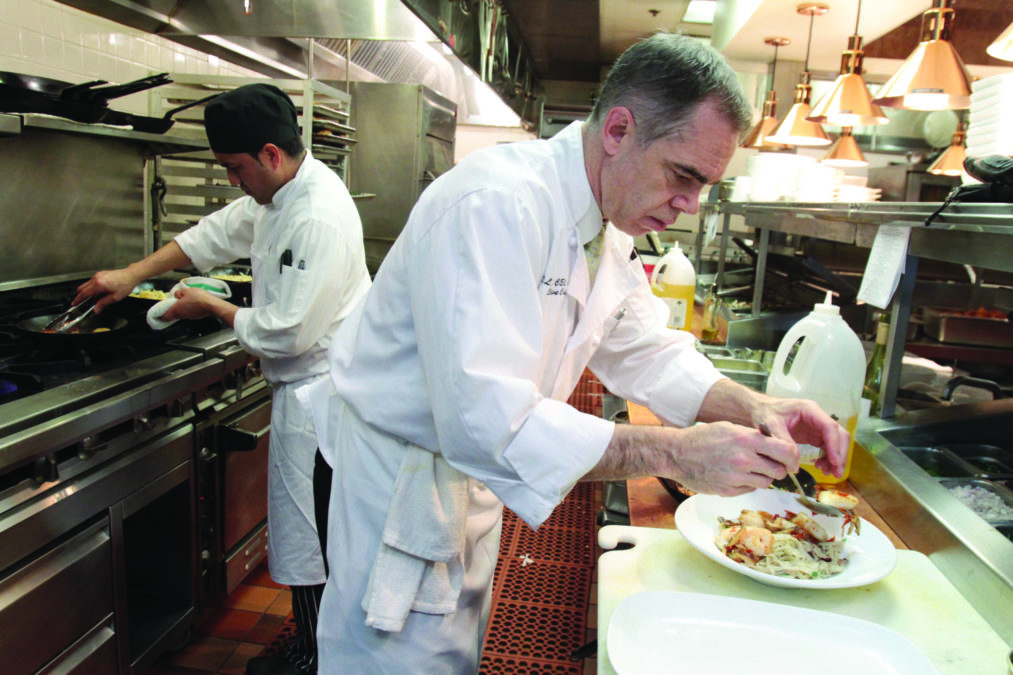
Because Hannum quietly strived to exceed expectations—not just meet them—he quickly moved up the ranks. By 1994, he was overseeing the hotel’s entire kitchen operation. Banks returned to the hotel after graduating from the Culinary Institute of America—where he and Butler were roommates.
From Banks’ nostalgic point of view, the height of The Green Room “swagger” was in the mid-1970s to late ‘80s. Indeed, the chefs had bragging rights. In 1981, Hannum took part in an international exchange with the Imperial Hotel in Tokyo, where he cooked for two weeks.
In the 1980s, the hotel offered 10-course tasting menus with wine pairings long before chefs in New York or Chicago had started them, Hannum maintains. Up to 100 diners at a time attended the hotel’s gourmet dinners.
Every Thursday, Butler and his colleagues began opening oysters at 2 p.m. for that night’s seafood buffet. “It was mind-boggling,” he says of the volume. No one complained. They knew there were other ambitious cooks eagers to prove themselves; the kitchen was highly competitive.
“It was bustling,” says D’Amico. “We had both dining rooms open—the Green Room and the Brandywine Room—and banquets. The Brandywine Room was open after the show at The Playhouse, and we’d do 120 covers after the show. It was nonstop.”
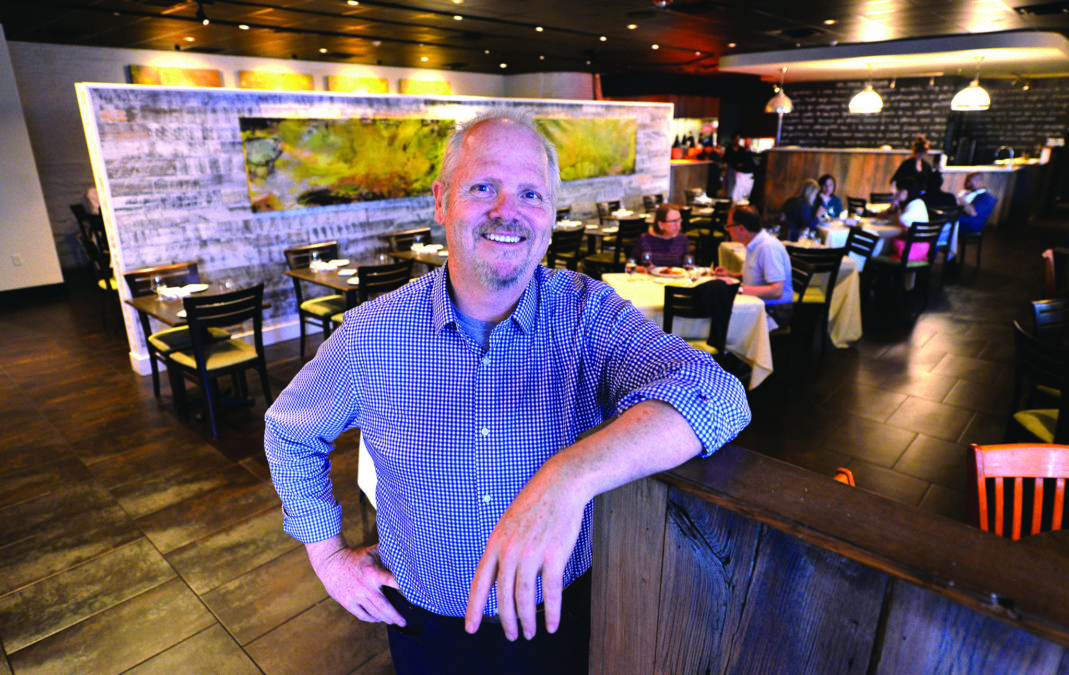
The front of the house was equally hectic. Robert Lhulier became a server in 1988 on a dare. He’d previously worked at Air Transport Command in New Castle, where his peroxide hair offended his manager.
“He said a place like the Green Room would never hire me,” recalls Lhulier, now a chef with his own business. “And so, I quit and applied—not before deciding I wanted that job more than anything.” He wanted it so much that he decided to return to his natural hair color.
The banquet staff revered and feared Berndt Mayer, the hotel’s director of banquets. Lhulier, then 22, paid careful attention to the plaque on maître d’ Ed Barba’s desk that read: “Listen.” “You can learn an awful lot when you’re young if you shut up and listen every once in a while,” Lhulier says.
A year after starting, he became a captain, a job that required tableside service, says Roger Surpin, who held the position in 2006 after graduating from the Culinary Institute of America. “We would do tableside Caesar salads, chateaubriand and seafood Christina (shrimp, scallop and crab cooked in lobster sauce and flambéed with Pernod). It was a lot of fun.”
Sweet Somethings
No high-end meal at the hotel was complete without dessert. The hotel had long employed pastry chefs, but a female had never managed the bakery. That changed on June 1, 1988, when General Manager Jacques Amblard hired Michele Mitchell on her birthday.
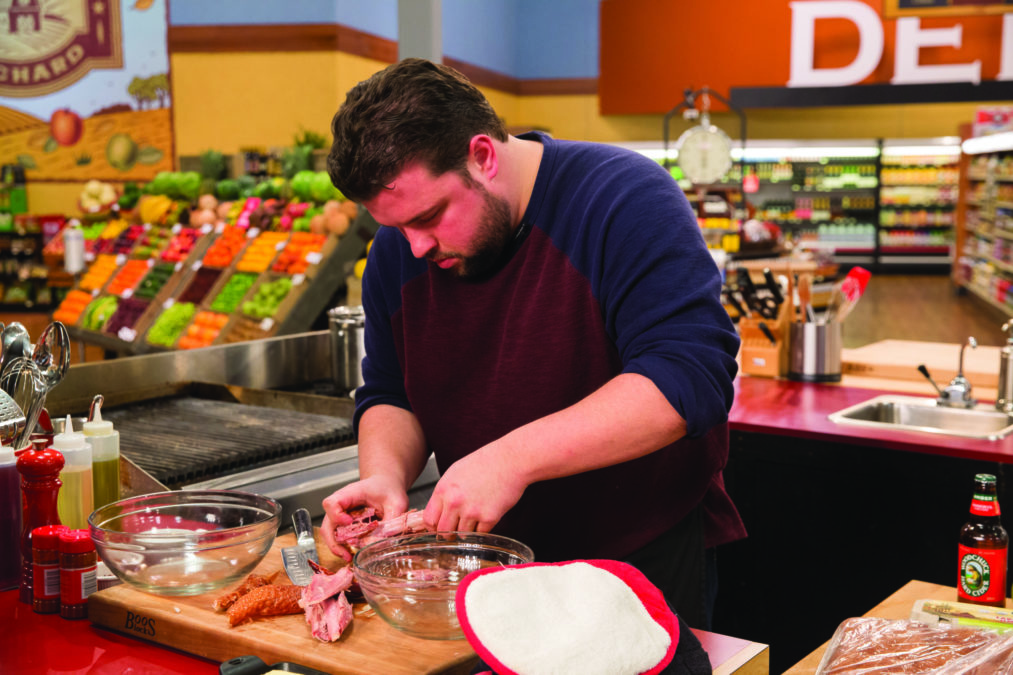
At the time, the bakeshop had three men for every female employee. That was also true in the kitchen, except for the cold foods area, where Italian women worked under males. Mitchell was the only female manager. “Keep up the great work!” Amblard told her each morning. Along with supervising the hotel’s pastry, Mitchell oversaw the baked goods for the DuPont Country Club.
Hannum helped her navigate DuPont’s corporate waters. “He displayed a great loyalty and feeling for the history of the property,” she recalls. When the Historic Hotels of America asked the hotel to participate in a James Beard House dinner, Hannum suggested that Mitchell go to New York. He would be her sous. “No other chef I know would have done that,” she says. “It is such an honor to cook at the James Beard House. I was so humbled that he gave me that honor.”
The Next Generation
Mitchell and Hannum were on hand when another wave of promising chefs joined the team. These culinary whiz kids insist that they helped create a new heyday for the Green Room, which was closing in on 100.
After opening Positano and Eclipse Bistro, D’Amico returned to the hotel as the executive sous chef. “I had the best crew that I’ve ever had in my life,” says D’Amico, now the executive chef of Chattanooga-based Vision Hospitality Group. “No one could match us at that time.”
The team included Bill Hoffman, Dan Sheridan, Andy Feeley, now executive sous chef at Lincoln Financial Field, and Robbie Jester, now the culinary director and multi-unit manager for High 5 Hospitality, owner of the Stone Balloon, Buffalo Wild Wings, Limestone BBQ, and Eggspectation.
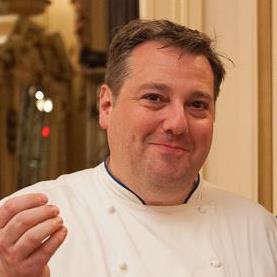
“It was the most intimidated I’ve felt walking into a kitchen to work,” says Jester, hired in 2005 to be a senior line cook and as a “floater” between stations. “The level of intensity, history and emerging talent was infectious to be around.”
D’Amico was the poster child for the intensity it takes to be exceptional, Jester says. Sheridan would agree.
“He’s a unique character, to say the least, with a huge heart. He shared his knowledge with me, and I was still pretty green,” says Sheridan, who started in 2007. “Working with that crew is by far the most beneficial stretch of work I’ve ever had personally.”
Hoffman was a teacher as well as a cook, says Jester, who learned from Hoffman that “you have to educate and elevate those around you.” From Hannum, Jester learned the value of classical technique.
It was not unusual for D’Amico to take the menus away from up to eight tables of trusting diners to create a tasting menu. “We were freestyling,” he says. They mixed and matched dishes. “Billy may have started it off with the first table but ended at the second.”
In Hoffman’s opinion, the crew was pushing the boundaries at a breakthrough time in culinary technique. “We wanted to put our stamp on [the hotel’s cuisine] while still keeping all our accolades,” he says.
Finding Fame
Hoffman’s favorite memory was when he cooked for actress Julie Andrews, who had a production at The Playhouse. The Mary Poppins star came in at 11 p.m. with a group. The Green Room had closed, but D’Amico and Hoffman quickly opened the kitchen for them. “That was my hero: Mary Poppins,” Hoffman says. “We cooked until 2 a.m. I had to pinch myself.” The chefs later cooked for Andrews’ 90th birthday.
Given the proximity of The Playhouse—which was also the DuPont Theatre for a time—it was common to see celebrities. Dignitaries also stayed in the hotel when they were in town. Mitchell remembers one late night in the bakeshop when Amblard asked her to follow him.
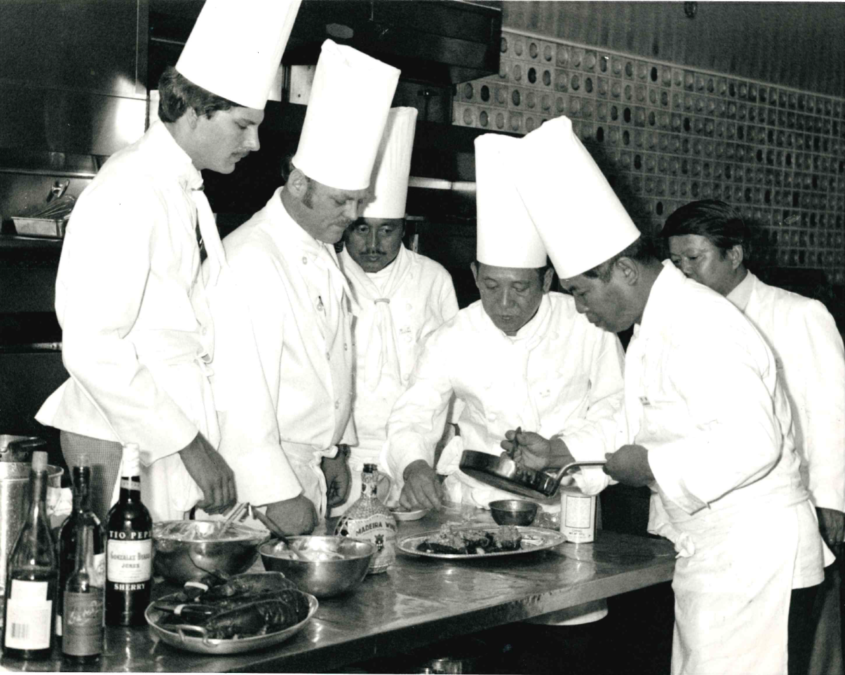
Hotel du Pont America Week in Japan (July, 1981).
She watched as a Secret Service man walked out of an elevator, followed by President George H.W. Bush. “As the president was shaking my hand, Jacques introduced me as the ‘lady in charge of those macaroon cookies you liked so much,’” she says. Bush replied: “Well, this is now the favorite person I’ve met tonight.” Mitchell was thrilled.
Mitchell left the hotel in 2018 to start her own business; Hannum retired in 2011 and opened Buckley’s Tavern with partners. When the hotel went up for sale, the partners tried to buy it. “We wanted to get the hotel back to what it used to be,” Hannum says. “But alas, we were the second-place bidder twice.”
Although it took the Green Room longer than most longtime restaurants to morph into Le Cavalier, things eventually change. But the old grande dame did not entirely give up the ghost. “As long as that building stands, so will the memories of the Green Room,” Lhulier maintains.
And for those who worked there, the restaurant will have a lasting effect. Says Jester, “My time there taught me to be a lifetime scholar of this business and all of its parts.”
A Proud Tradition Continues
Tyler Akin, chef-partner of Le Cavalier at the Green Room, continues the Hotel du Pont tradition of showcasing local culinary talent. A native of Wilmington, Akin spent most of his childhood in the kitchen admiring his Southern grandmother as she made perfect knife cuts and prepared abundant family meals. His mother, who worked as a special education teacher, also made a point to keep this tradition alive at home and cooked nightly.

Originally enrolled in law school, Akin changed direction to pursue his passion for food and hospitality, enrolling at L’Academie de Cuisine in Washington, DC. In 2010 Akin began cooking at Michelin-starred Komi under chef-owner Johnny Monis, who became an inspirational figure in Akin’s career. He helped Monis open Little Serow in 2011, which debuted to mass critical acclaim and was awarded a coveted spot on Bon Appétit’s top ten “Best New Restaurants in America.” In 2012, Akin relocated to Philadelphia to accept a position at Zahav under multi-James Beard Foundation award-winning chef and restaurateur, Michael Solomonov. Akin quickly found a mentor in Solomonov, rising in the ranks at Zahav and becoming a Sous Chef before deciding to venture out on his own in 2014.
Akin’s first restaurant was Stock in Philly’s Fishtown section. The restaurant made Philadelphia Magazine’s “Best Restaurants in Philadelphia” lists for five consecutive years. In 2016 he opened Res Ipsa Café, also to critical acclaim. Akin opened a second location for Stock in 2017, this one in Philly’s Rittenhouse neighborhood.
Le Cavalier at the Green Room brings Akin back to the city where his love of food first started. It also enables play a leading role in the next chapter of Hotel du Pont culinary history.





